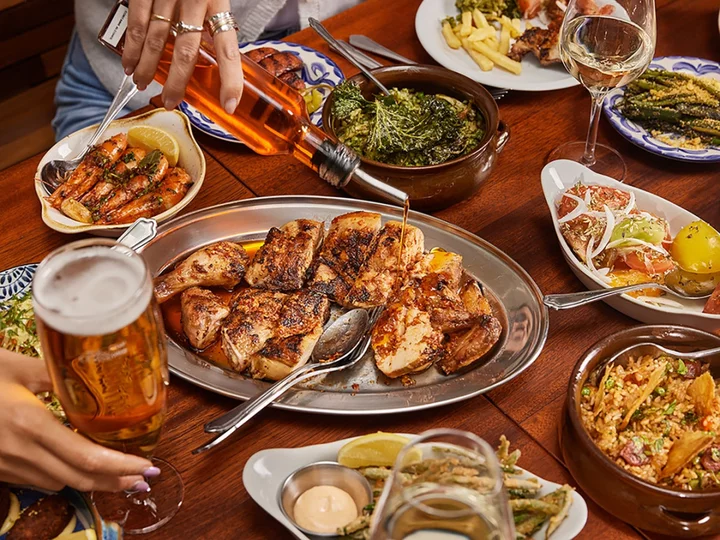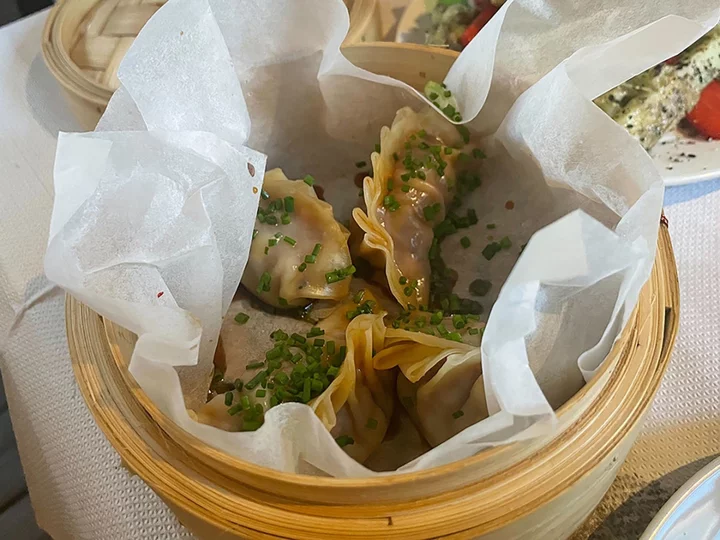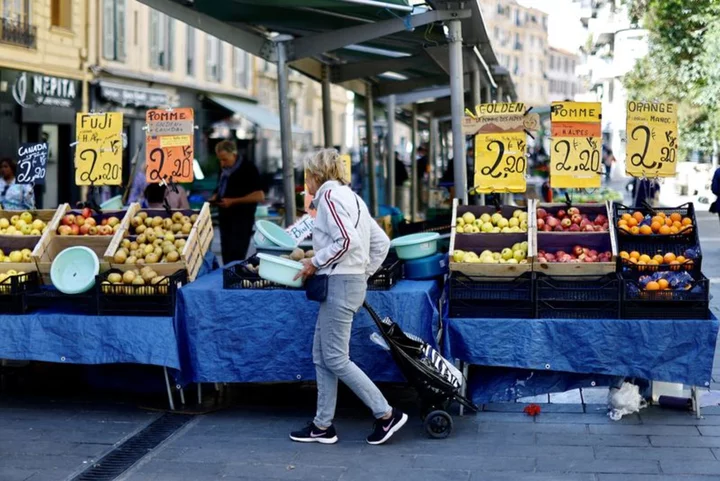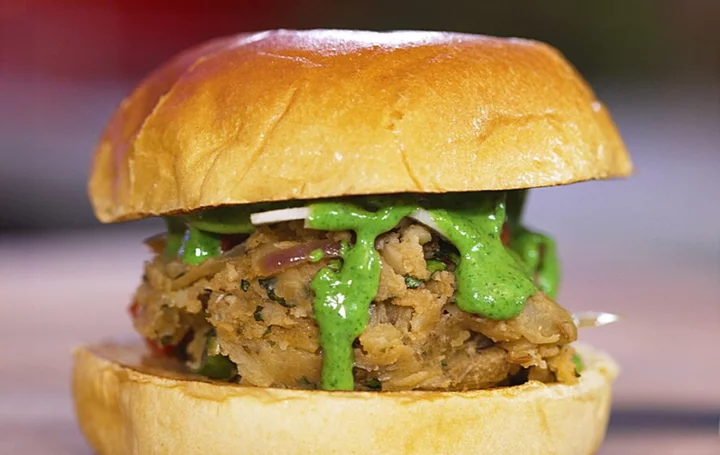
The UK economy still can't cope with the consequences of Brexit
The UK government has delayed health and safety checks on food imports from the European Union for the fifth time in three years amid fears that the additional red tape will push up food prices and disrupt vital supplies.
2023-08-30 00:45

The dish that defines me: Evelin Eros’s rum cake
Defining Dishes is an IndyEats column that explores the significance of food at key moments in our lives. From recipes that have been passed down for generations, to flavours that hold a special place in our hearts, food shapes every part of our lives in ways we might not have ever imagined. As a teenager growing up in Hungary, the summer school holidays were usually spent at home because my parents were still working. They would leave us a list of house chores we needed to do before they left for work in the morning, and it included cooking our own meals, so I learned at an early age that I really enjoy cooking. I love cooking traditional Hungarian food, but I was also keen to experiment with other recipes and there was one day when I was looking for something to cook for that evening, just anything. My friends and I would go to the local library regularly, and on this day, I went and found an old cookbook in the food section. It looked about a hundred years old, it was falling apart, some pages were missing and others were stuck together. But I browsed through it and found a cake recipe involving plums soaked in rum that I thought sounded delicious. The recipe was incomplete because of the state of the book, but I wrote it down in my notebook anyway because it sounded good and I really wanted to try it. I resolved to make it for our dessert that evening. I went to the supermarket and went to search for all the ingredients for the cake. What I wasn’t expecting at the time was how expensive they would be – thinking back now, it makes sense that rum, plums and vanilla would not come cheap, but I was young and didn’t really know the price of things like that. It turned out to be quite an expensive shop, particularly for a 16-year-old using her own pocket money, but I didn’t mind too much as I was convinced it would be great! I got home and started getting ready to cook. It was around this time that I realised just how incomplete the recipe was. It confused me – for example, it seemed to call for just milk and eggs in the batter, there was no flour. But I pressed on and told myself that the recipe writers surely knew what they were doing. I mixed everything in a bowl and it was very, very liquidy, almost like water, which worried me. I poured the batter into a pan and into the oven it went. Now, the recipe said it would only take 20 minutes to cook. But as much as I wanted to trust the recipe, this part made me doubtful because of how liquid the batter was. So I waited and waited, but it remained stubbornly liquid. I wasn’t even sure if it would be edible. After an hour and a half of waiting, I used the toothpick method to see if it was cooked. I inserted the toothpick into the middle of the cake and when I removed it, it was sticky but no batter was left on it, so it looked like it might be OK to take it out. By this time, I had used so much electricity and energy that I was anxious to get it out of the oven. I took it out and left it on the kitchen counter to cool down. I told myself: “Maybe it will be solid by the time I come back.” It did smell amazing because of the vanilla and rum and plums, almost like Christmas cake that filled the house. But to be honest, I had a bad feeling about it. It looked horrendous, the most disgusting-looking cake I had ever seen. At least it looked solid, so I thought OK, that seems fine-ish. After a while, I figured it had cooled down enough so I tried to get it out of the tin. I had used a cake tin that you push up from the bottom to release the cake. While I was pushing the bottom, I don’t know what happened, but the cake slipped and the whole thing just fell onto its face on the floor. I remember standing there for a moment and thinking, I just spent a bloody fortune on this cake and it’s fallen in the dirt on the floor. I rushed to my room in tears, I just couldn’t deal with it. I was so sad. My 18-year-old brother had been in his room the whole time and heard me slamming my door. He must have wondered what happened because I heard him come out of his room and go downstairs to the kitchen. I stayed in my room for a little while feeling sorry for myself, before pulling myself together and heading back out to go and clean up the mess I made. I went down the stairs and I kid you not, saw the funniest scene before my eyes. My brother was on his knees in the kitchen, literally eating the cake from off the floor. I said: “What the hell are you doing?” He told me it smelled and tasted amazing, he couldn’t resist. It reminded me of the Friends episode “The One with All The Cheesecakes”, because there is a scene where Rachel and Chandler are eating cheesecake off the floor in their hallway. It was hilarious that it was happening to me in real life. I didn’t join my brother on the floor, but I did try a little bit of the cake once we picked it up from the floor. It was really tasty even though it wasn’t quite done, but it wasn’t the total failure I thought it was going to be. He offered to get me more eggs so I could try and recreate it again. The next time I made it, I made some adjustments and it turned out bloody amazing. Now, after a lot of experimenting and tweaking the original recipe, I’ve kind of mastered it. It is still expensive to make, so I decided I would only make it for celebrations and for Christmas. I even entered my recipe in an online competition. One of the prizes was a Jamie Oliver cookbook and my dad absolutely adored him. I enlisted his help to submit my entry because I didn’t have a laptop at the time, and it turned out to be a fun thing for us to do together. Some time later, I checked my email and found out I won the competition! Both Dad and I were stunned because I was worried my recipe was too complicated and nobody would want to make it. When we received the book prize, Dad was definitely more pleased than I was. It was a great thing for both of us to do. I genuinely believe that making this cake taught me the power of not giving up. That lesson has followed me throughout my life ever since. I am now an archaeologist living in Glasgow, but it hasn’t been an easy journey. I have had to persist with things even if they don’t go according to plan and keep motivating myself to get here. I think this random cake I picked out of an old book in a library has helped shape my attitude towards life. I’m also really glad my brother ate it off the floor because if he hadn’t, I would never have learned those lessons and maybe, I would be in a very different place today. Evelin Eros is a Hungarian archaeologist living in Glasgow. She makes her rum cake every Christmas and for other special occasions. Read More The dish that defines me: Mallini Kannan’s baked honey-soy salmon The dish that defines me: Frank Yeung’s prawn wontons The dish that defines me: Alex Outhwaite’s Vietnamese bun cha ‘It started with a radish’: Chef Simon Rogan reflects on restaurant L’Enclume at 20 The true story – and murky history – of Portuguese piri piri oil ‘My depression stopped me doing what I loved most in life – cooking’
2023-08-29 19:16

Why Artificial Banana Flavor Doesn’t Quite Taste Like Bananas
Despite what people often claim, the Gros Michel isn't to blame.
2023-08-29 03:18

Pastrami vs. Corned Beef: What's the Difference?
The two brined meats are both delicious, but they're prepared in very different ways.
2023-08-29 01:25

Pizza, cake and meringue martinis: When did cinema food get so silly?
As I sit in the dark of Screen 2 at Oxford’s Curzon cinema, a woman a few seats away from me does something I’ve not seen before: she orders pizza. Specifically, she orders £64.85 worth of pizzas and chips for her and her family. A few minutes later – after the film has started, in fact – the food is brought to her, as though she was sitting in any regular restaurant and not in a cinema. Eating at the pictures is becoming ever more sophisticated, with ushers bringing you food as fancy as sushi without you having to move a muscle. Is it getting a bit silly? It’s no secret that cinemas have endured a range of crises over the past few years, partly thanks to the rise of streaming and then the pandemic and even more streaming. Cinemas across the country have shut down and forecasters predict that screens won’t be as full as they were pre-Covid until 2025. Some of the cinemas that survived, like AMC, are saddled with billions of pounds worth of debt. Just showing people films may not cut it in this difficult new era. As they fight to survive, cinemas are having to up their game. They have to offer “experiences”. Christina Flourentzou, operations manager at Curzon, says they learned that customers wanted more food and drink with their film thanks to their feedback service, Feed It Back. This happened before Covid struck, she points out, but post-pandemic the company rolled their restaurants out on a bigger scale. “What we’re trying to do is elevate the guest experience,” she says. “For us it’s about giving the guest the best possible experience; so anything that they want, we can give them, essentially.” At my local Curzon this includes padron peppers, mushroom and truffle croquettes, and vegan hot dogs. What Curzon has discovered, according to Flourentzou, is that when at-seat food and drink service is offered, the spend per customer goes up – often by as much as £2 per person. There is a different mindset when ordering at your seat compared with ordering at the till: “You take your coat off, your hands are free, you look at a menu, suddenly someone comes to you and says, ‘What would you like?’ Your mentality changes.” On any new site Curzon will now endeavour to install tables at seats, in order to allow for this in-screen service. Eating entire meals in your cinema seat is becoming more and more popular but it isn’t a brand-new phenomenon. Studio Movie Grill, born in Texas but with sites in states including California, Florida and Georgia, has been offering at-seat food and drink since 2000. Tearlach Hutcheson, the company’s vice president for film, calls this kind of operation a “cinema eatery”. He agrees that it isn’t just the pandemic that has caused a shift in customer priorities; it’s been happening over the past 20 years as home entertainment systems have become increasingly more sophisticated and cinemas have had to compete. “I think that people are looking for a different experience when they go to the theatres,” he says. “We have to provide a more luxurious catering experience to the guest.” I think the immersion is only going to get more and more. I think that everyone is going to adapt because this is what people want. I don’t think the cinema is enough now ... I don’t think it’s ever going to go back to popcorn and drinks Amy Fernando, creator of Taste Film At Studio Movie Grill, food revenue is more than twice that of ticket sales, and its CEO says that business is better for the company than before the pandemic. In cinemas, profit margins have always been higher on food than on tickets – though these margins are far smaller for cooked food than for popcorn and Coke. The kitchen staff at Studio Movie Grill are often dishing out six meals per minute. A recent innovation was a kitchen printer that printed orders faster than ever before. Servers are allowed to bring food and drink to guests at any point (unlike Curzon, where, Flourentzou says, it should strictly happen during the adverts and trailers) but the bulk of orders are placed within the first 30 minutes of arrival. Studio Movie Grill could represent the future of the cinema-going experience: it might soon be completely normal to bundle the film-and-a-meal experience into one. What Hutcheson is confident about is that cinemas will become more of a “destination spot” in order to entice people to leave the comfort of their homes. Flourentzou doesn’t think I’m right to call it “panic” but it does seem like cinemas are urgently fighting to stay alive. One person who knows all about using food and cinema to create an experience is Amy Fernando, creator of Taste Film, an enterprise that shows films to customers while serving them food featured in those films. Watching Goodfellas in 2016, Fernando was inspired by the infamous shaving garlic scene to marry the two things she cared most about. Seven years later, she has swapped teaching for running the business full-time. “I think the beauty of coming to the cinema, or doing an experience like this, is sharing it with like-minded people,” she says. “Post-Covid there is something special in getting dressed up, going out, and sharing the experience with other people.” When I go to watch Taste Film’s version of Mrs Doubtfire, I agree. I didn’t think of the film as one featuring all that much food but at appropriate moments we are served a savoury birthday muffin; chilli salt and pepper chicken wings; a meringue martini; tiger prawn skewers with chips and salad; a pina colada; and a chilli and chocolate mousse. As Fernando says, the frisson of fun is largely to do with two communal experiences: everyone not just watching the film at the same time but eating the same food at the same time. This won’t be replicable in regular cinemas (a Taste Film ticket is £75, for example) but the company is going from strength to strength, partnering with the big streamers, and its growth is indicative of people’s updated expectations around film. “Guests want more,” says Fernando, “and younger people want more.” Ultimately, of course, it will be the quality of films that govern whether or not cinemas stay afloat. This summer has seen an unusual boom in quality and business, with Barbie and Oppenheimer proving critical darlings as well as excellent earners. But where the cinemas can’t control how good the films are, they can control the various offerings they provide around them. “I think the immersion is only going to get more and more,” says Fernando. “I think that everyone is going to adapt because this is what people want. I don’t think the cinema is enough now.” Hutcheson and Flourentzou agree. Hand in hand with this development, Hutcheson says, will be a resurgence in “purer cinematic experiences” – people wanting to experience cinema with as sophisticated a picture and sound experience as possible. He believes that it won’t be long before cinema eateries – at the moment confined to more modest theatres – will also enter the IMAX space. Look at the signs and it certainly seems as though it will be difficult to put the genie back in the bottle – which means cinemagoers may need to brace themselves for an exciting new range of smells. Fernando is probably right when she says: “I don’t think it’s ever going to go back to popcorn and drinks.” Read More Too gay, too weird, too pregnant: The most controversial Barbie dolls in history Doing things alone isn’t ‘self-love’ – we don’t need to make everything empowering Sizzling kitchen drama The Bear is spicing up the dating game for chefs ‘It started with a radish’: Chef Simon Rogan reflects on restaurant L’Enclume at 20 The true story – and murky history – of Portuguese piri piri oil 30-minute summer recipes for all the family to enjoy
2023-08-27 15:30

Michelin-starred chef Simon Rogan on 20 years of L’Enclume: ‘It all started with a radish’
In Cartmel, a picture-postcard Cumbrian village on the cusp of the Lake District, chefs in their whites are scurrying across the cobbled streets like an army of well-dressed worker ants. Some are heaving wheelbarrows stacked with mounds of freshly picked vegetables, still earthy from the farm; others are dashing from one building to another, precariously balancing enormous stacks of clean pans. They all have one thing in common: they work for Simon Rogan. If they’re the workers, he’s the queen. This well-rehearsed choreography is a typical sight every morning in Cartmel, where the Michelin-starred chef – one of only eight to own a three-starred restaurant in the UK – set up shop 20 years ago. After a decade of working at various levels in restaurants around the country (including a placement under Marco Pierre White and two years at the three-star Lucas Carton in Paris), Rogan was keen to open his own restaurant. Priced out of Hampshire and Sussex, he looked further afield and found a rundown 800-year-old former smithy in Cartmel available to rent. “I didn’t come here for anything as glamorous as the area or the scenery or the people,” he tells me, having just taken me on a tour of said area to meet said people. “It was just for this building. I was desperate for my own restaurant. I felt like I had never really achieved the things that I’d wanted to working for other people. I wanted to make my own mistakes and be in control of our own destiny. I know it sounds cheesy, but it’s true.” He made an offer on his way back from his first visit to the area, and L’Enclume was born. “Once you realise where you are, you think: s***, this is beautiful,” he adds, laughing. Over the next two decades, the ambitious chef transformed the Cumbrian village into a culinary destination unlike anywhere else in the UK. It’s now home to not only L’Enclume – awarded the environmental green star in 2021 and the coveted third star in last year’s Michelin Guide – but also the one-starred neighbourhood eatery Rogan & Co, and Aulis, L’Enclume’s six-seater chef’s table behind the main restaurant. He also put his name to Henrock, a more informal and relaxed offering just a half hour’s drive away at Linthwaite House, overlooking Lake Windermere. The engine behind this mini empire, and the reason I’m here, is Our Farm, a 12-acre plot in Cartmel that supplies the majority of the restaurants’ ingredients. A sustainable, closed-loop growing operation had always been “at the back of his mind”, Rogan says. He was inspired by his father, a fruit and vegetable salesman who would bring home a box of the day’s best produce, teaching him the importance of using every part of the ingredient. When they arrived in Cartmel to get started, though, “the standard of produce”, Rogan says “was absolutely rubbish. The reason we got into farming was my frustration at the ability to buy a perfect radish, which is the easiest thing in the world to grow.” They rented a small plot close to the restaurant, and filled in the gaps with local suppliers. But, back in 2002, it was too expensive to buy organic. “Things were triple the price they are now,” Rogan tells me, taking a sip of his beetroot juice at the Aulis counter. “So we bought little bits and pieces here and there alongside the normal suppliers. Then we had the opportunity to take over the farm. That’s when we thought: ‘Right, let’s start growing radishes.’” What started as a little garden has become something bigger than he could ever have anticipated. A restaurant growing its own produce is not a groundbreaking concept, but a kitchen garden this is not. You won’t find pristine beds and trimmed rose bushes and arty ornaments. But you will find a patchwork of muddy fields growing hardy vegetables, the topsoil painstakingly “fluffed” by hand; a regiment of polytunnels housing the more finicky plants, delicate micro herbs and other culinary experiments (I try something that tastes like pickled onion Monster Munch); and enormous hand-rotated compost bins that process all the food waste from the restaurants into mulch for the farm. All this is surrounded by hedgerows that have been carefully curated to attract birds and other wildlife to act as natural pesticides. None of this would be possible without head farmer John Rowland. Regenerative agriculture might be his trade, but birds are his true passion. During a tour of the farm, he lists off the species he’s seen circling overhead, drawn by the blackthorn, hawthorn, rowan and birch trees he’s been planting on the borders. “We cater for the birds more than the people,” he tells me, in a Welsh accent so bucolic I wonder whether he’s been shipped in specifically for the tour. “Everything on the farm has a use, and not only in a culinary way. The seeds and the berries attract the birds onto the farm. The birds are my pest control, so the more I can attract to the farm, the more pest control I have, and that is fantastic for birdlife. In Britain, we’ve lost 84 per cent of our bird species, but this area is really rich because of these techniques.” While he might prefer looking upwards, it’s what’s beneath our feet that Rowland is really focused on. “The life is in the soil,” he says, grabbing a great fistful of the stuff. “You have hundreds of types of fungus right here. We don’t want to disturb that biome in the ground so rather than rotavating the soil [breaking up the earth with a machine ready for planting] and destroying the millions of organisms that live in it, we build a six-inch layer of compost on top and aerate it with a fork. Once you’ve done that, each year you just top it off with an inch, and that’s regenerative farming,” he says matter-of-factly, clapping the dirt from his hands. Well, that’s the gist anyway, and while it’s perhaps a little more complicated than that, Rowland struggles to understand why more people aren’t farming in this way. “We’re the most nature-depleted country in the world. We’ve lost our wildflower meadows, we’ve lost our insect population, we’ve lost our wild songbird population. They’ve taken the hedgerows away to make the fields bigger. All the natural food in our countryside is being lost to intensive farming.” Regenerative techniques like those Rowland is putting into practice on Our Farm would go some way to reclaiming it, he says, but “it’s a shame that they don’t realise that”. He pauses for a moment, then corrects himself: “Well, it’s not that they don’t realise it. They know. It’s just that they want intensive farming because it makes them money and it’s wrong because we are killing everything.” How this translates to the table at L’Enclume is manifold. Every dish on the menu begins life on the farm, where Rowland will flag what’s in season and at its best, or suggest something new he’s been experimenting with. Or it might start as an ingredient foraged from the countryside or sourced from a local supplier. The idea is then tweaked in the development kitchen at Aulis, before it finally makes its way to the pass at L’Enclume. This results in a transient snapshot of Cumbrian cuisine that changes every time you dine, and a menu quite unlike anything else I’ve come across. When I visit in February, Boltardy beetroot – a variety chosen for its resistance to erratic weather – shines in a bitesize tart with smoked pike-perch fished locally, and perilla, a Southeast Asian herb cultivated on the farm that adds notes of mint and licorice. Elsewhere, there’s lovage and rose hip and lemon thyme, all foraged; there’s Cornish cod and Mylor prawns and potted shrimp and Maldon oysters; sweetcorn and champagne rhubarb from the farm that were fermented after they were harvested last summer so they could be used year-round; and an enormous selection of British cheeses, including Tunworth, which is frozen and crumbled in a palate-perplexing, salty-sweet dessert. It happens to be my favourite dish. Managing a farm-to-fork operation this complex, not to mention the empire, is no mean feat. “I could pretty confidently be a tax exile given how little I am in the UK at the moment,” he jokes. When we chatted in February, the team was preparing to revive their pre-Covid plan for a five-week residency in Sydney, which concluded this month. The punchline, of course, is the delay meant Aussies were given a taste of not a two-star L’Enclume, but all four stars. Given Australia is yet to receive a Michelin Guide and is not particularly well known for its agricultural sustainability, it was an interesting move, but one there is clearly appetite for. Despite the $420-a-head price tag, it was sold out, serving more than 4,000 diners. While the food at L’Enclume, at home and abroad, is clearly special, it’s the people that set it apart from other restaurants in this league. Their hospitality, affability and, perhaps most noticeably, northern accents, are not typically what you find at this price bracket (£250 a head for the tasting menu, plus £100-£290 for a pairing). Stuffiness is neither present nor tolerated. Many of the staff have been with Rogan since the beginning, switched between the restaurants, or left for pastures new only to return. “We get a lot of people coming back – only the ones we want, anyway,” he says slyly. There’s certainly been a few famous quarrels. The “Rogan alumni” is a term thrown around a lot during my visit, and includes Mark Birchall, who was executive chef at L’Enclume during its two-star era before setting up a curiously similar “restaurant with rooms”, Moor Hall, in Lancashire, which also boasts two stars and a further green. Then there’s Dan Cox, who cut his teeth at Rogan’s now-closed Fera in Claridges as well as L’Enclume, and helped him set up Our Farm in the early days. He’s now down in Cornwall, running the farm-to-table Crocadon. But, generally, people are drawn back to L’Enclume for the variety it has to offer. “Look around the country,” says Rogan, “and [other restaurants] haven’t got any staff because they can’t offer as many career progression opportunities for people. I suppose that makes them lucky. “It’s about not spreading yourself too thin. We’re only able to do these things because these guys are really, really hungry.” Acknowledging that hunger, he established the Simon Rogan Academy in 2021 to “nurture aspiring chefs”. It includes paid work across the Cartmel restaurants, and culminates in a week-long placement at his restaurant Roganic in Hong Kong. In the beginning, “we thought that maybe if we had just a third of them left at the end of the quarter, it’d be brilliant,” Rogan tells me. “But almost all of them stayed on! And now they all want jobs” – he comically rolls his eyes – “but really it’s great.” As I drift between the farm and the Cartmel restaurants, everyone hard at work but always smiling, it strikes me that L’Enclume isn’t just a restaurant; it’s a story. And its influence is immense. “Sustainability”, “farm-to-table” and “regenerative agriculture” were mere whisperings 20 years ago. Now they’re affixed to almost every new menu, and you could say they were born here. The people I’ve met could well be the next batch of Rogan alumni, attracting Michelin’s attention with their own restaurants in years to come. If it takes 20 years to craft a legacy like this, then I’ll make sure I come back in 2043. For more information about L’Enclume, visit www.lenclume.co.uk and for more information about Simon Rogan and his other restaurants visit www.simonrogan.co.uk Read More Why I won’t be doing Veganuary this year – or ever again Marina O’Loughlin is wrong – there’s joy in solo dining Michel Roux Jr announces closure of renowned restaurant Le Gavroche to have ‘better work/life balance’ The true story – and murky history – of Portuguese piri piri oil 30-minute summer recipes for all the family to enjoy What to cook this week: Tomato tart, sweetcorn pasta and other summery suppers
2023-08-27 13:56

I feel it in my fingers: Why more of us should start eating with our hands
The next time you eat something with your hands, take a moment to notice how it feels on your fingertips before taking a bite. If it’s a burger, are the buns smooth or covered in a smattering of sesame seeds? When you put pressure on them with your fingers, does the bread squish down or is it more of a crumby affair? Then, when you finally take a bite, notice how satisfying it is to sink your teeth through its layers; soft bun giving way to crunchy lettuce or onion, to oozy cheese to, finally, juicy patty. Now think about how different it would be if you had used a knife and fork. Eating with one’s hands is an immensely pleasurable experience. While in the West, the act is usually confined to foods encased in bread or pastry, Indian, African and some other Asian cultures are more adept at using their fingers for dishes that might seem too “messy” or “sticky” on this side of the world. One of my favourite dishes is banana leaf rice, which at its core comprises of rice, vegetables and curry. I mix each element of the dish and use a pinching motion with all five fingers to construct the perfect bite, before sweeping it up in a quick motion and delivering the food to my mouth. I find that it forces me to really consider each bite, from what flavours and textures I want it to contain, to how large a portion I can manage. Up until a few months ago, I never really thought about how often I eat with my hands. Like many people, I associated it closely with Indian meals and always thought that Western culture was too obsessed with polite society to really dig their fingers in. This is still true, to an extent – many South Asians who grew up eating with their hands report being looked at with horror when they attempted to do the same in public here. But, after witnessing my very white British husband happily dig into banana leaf rice when we began dating, and having conversations with friends about the topic, I’ve come to realise that eating with our hands is a much more universal act than I thought. For example, burgers, pizzas, hot dogs and chips are all eaten by hand – unless you’re eating one of those beastly burgers that tower too high and need to be deconstructed. Then there’s things like fried chicken or shellfish, which are simply easier to pick up, pull apart and pry open using your fingers. Foods like Mexican burritos and tacos or Japanese sushi are commonly picked up by hand and devoured. Some people enjoy eating salads by hand, finding it easier to use pieces of lettuce filled with dressing and other ingredients like edible spoons. A surprising proponent of this was Sylvia Plath, who wrote in the third chapter of her 1963 novel The Bell Jar that she observed a poet eating a salad “with his fingers, leaf by leaf”, making it “seem to be the only natural and sensible thing to do”. The more I think about it, the more I realise that my hands are my favourite utensil. No one is delicately picking up crisps with chopsticks or forking a French fry. All manner of flat breads – from parathas and naans to injeras – beg to be torn apart by hands and used to mop up dhal and curry. I would never think of eating a sandwich with a fork and knife, any more than I would for a Taiwanese bao. It just seems wrong. On this side of the world, cutlery has reigned supreme until very recently. Primitive humans have been carving knife and spoon-like implements for centuries, while the fork is a surprisingly modern invention. According to the Smithsonian Magazine, a Byzantine princess debuted a golden fork at her wedding feast in Venice 1006, which disgusted locals who ate using their fingers and knives. One Venetian apparently condemned such a tool and said: “God in his wisdom has provided man with natural forks – his fingers. Therefore it is an insult to him to substitute artificial metal forks for them when eating.” There’s perhaps also an aspect of self-consciousness being thrown out the window when we eat with our hands. It banishes the concept of formality and Anglocentric ‘table manners’ Surekha Ragavan Despite the initial rejection, forks became a mainstay across Europe after 1533 when Catherine De Medici, wife of Henry II, hauled a collection of silver forks from Italy to France in 1533. Three hundred years later, the full set of silverware as we know it had integrated itself into everyday life in Europe. Manners-obsessed Victorians then made up all sorts of etiquette rules, from how to hold a fork, to the myriad of different-sized cutleries with very specific purposes – like fish knives and dessert spoons. These became class markers, separating the upper echelons of society with their dinky utensils from the lower classes, who worked too much to care about which spoon went where. But one thing could be agreed upon – eating with one’s hands was considered impolite and vulgar in almost all culinary situations. That is, until about a decade ago when DeBrett’s, the British authority on etiquette and behaviour, declared in their 2012 guide that “table manners are no longer about adhering to a rigid, and outdated, code of conduct”. The experts named foods like pizza and calzone as “acceptable” foods to be eaten using your hands. It also advised such adventurous eaters to create “as little mess as possible”, sit up straight and ensure you “never put your elbows on the table”, proving that some old habits die hard. Bristol-based restaurateur Rashintha Rodrigo, one of the five founders of Sri Lankan restaurant group The Coconut Tree, says he eats almost anything with his hands – even a roast dinner. “I start with a fork and knife but always find myself picking pieces of chicken or potato off my plate with my fingers towards the end of the meal,” he laughs. He also grew up eating rice and curry with his hands in Sri Lanka, and felt self-conscious about doing the same when he moved to Britain. But these days, he finds it liberating. “It’s become more accepted in the past five or six years and more people are curious about it,” Rodrigo says. Surekha Ragavan, founder of Periuk, a digital archive of heritage Malaysian recipes, also finds freedom in the act. “There’s perhaps also an aspect of self-consciousness being thrown out the window when we eat with our hands. It banishes the concept of formality and Anglocentric ‘table manners’,” she says, reminding me of another observation by Plath in The Bell Jar. The author’s liberation is slightly different, though, as she wrote: “I’d discovered, after a lot of extreme apprehension about what spoons to use, that if you do something incorrect at a table with a certain arrogance… nobody will think you are bad-mannered or poorly brought up. They will think you are original and very witty.” Those who advocate eating with hands often also say it makes the food taste better, but no one seems to be able to pinpoint why. Jose Pizzaro, the acclaimed Spanish owner and founder of the Pizarro group of restaurants, describes it as “the best way to eat”. “It’s a visceral pleasure that’s really hard to beat,” he says. “It creates a sort of magical connection between you and the food. If you’ve never eaten a big, fat, juicy prawn covered with garlic and lemon with your hands, and then go through the ritual of pulling off the legs and the shell and then sucking the brains out – you haven’t lived!” But why is the tactile sensation of touching food so delightful? Some opine that touching your food is beneficial because you can gauge food temperature better with your fingers, and so run a lower risk of burning your tongue. Others claim that your fingers have “healthy bacteria” on them that get transferred into your digestive system when you eat with your hands, but these are difficult to quantify. However, Charles Spence, professor of experimental psychology at the University of Oxford, believes the pleasure lies in our perception of food, as opposed to any other physical benefits. In his review of how the experience of eating changes when people eat with their hands instead of cutlery, Spence found that having more direct, tactile contact with food appears to “enhance the experience” of eating and drinking. “There’s a lot of sensory input that happens even before we put the food in our mouth,” he says. “Just by using our sensitive finger pads, we almost anticipate how tasty something is going to be before it reaches our tongue.” There’s practicality in using our hands to eat, too. We can determine how ripe a fruit is by squeezing it gently, or figure out if something is going to be soft or crunchy before biting into it. Of course, there are some dishes that are simply not hand-friendly. Noodles, pasta and soups obviously require cutlery to eat, but there’s nothing to stop us from taking more joy in the foods we can eat with our hands. If you’ve never tried handling anything beyond a sandwich or a pasty, I fully encourage you to try something new. Take a leaf out of Plath’s book with your next salad, perhaps, or take the plunge into some rice and curry. It will require practice to develop the skill of eating without dropping rice absolutely everywhere, but I promise you, it’s worth it. Read More Adorable, cuddly… evil? How the Furby took over the world ‘You think it’s going to be a money making machine’: How modern life killed the hobby The dish that defines me: Mallini Kannan’s baked honey-soy salmon 30-minute summer recipes for all the family to enjoy What to cook this week: Tomato tart, sweetcorn pasta and other summery suppers The dish that defines me: Mallini Kannan’s baked honey-soy salmon
2023-08-26 13:53

The true story – and murky history – of Portuguese piri piri oil
Most people in the UK think they know piri piri. Thanks to a certain restaurant chain, it is most closely associated with chargrilled chicken, floppy bits of halloumi, corn on the cob and bottomless fizzy drinks. But the chilli oil’s history is a little more nuanced and murky than that. During a recent trip to the Algarve, where “chicken houses” outnumber British expats, I went in search of the truth. While no one can seem to agree on its exact origins, it’s thought that during Portugal’s “mercantile” era, explorers discovered the bird’s eye chilli pepper – the main ingredient in today’s ubiquitous hot sauce – somewhere in the Americas in the 15th century. Seeing its potential to rival the “black gold” (black pepper) trade, they brought it back to their colonies in Africa to cultivate it before selling it on to Asia and Europe, significantly cutting down the shipping time. And so the global spice trade was born. But the plant suited Africa’s hot, dry climate and quickly became an important ingredient in local cooking. Fermenting it in the baking African sun and using it to marinade meat cooked over fire produced the first iteration of the classic piri piri flavour we know and love today. It wasn’t until the late Sixties, however, when Portuguese settlers and native Africans started arriving in southern Portugal, bringing with them this centuries-old technique and an appetite for spice, that it took off globally. Around the same time, chicken was becoming more affordable in Portugal, with poorer families buying whole birds to keep everyone fed and the famous “chicken houses” opening up across the Algarve offering an economical meal out. Pairing it with the piri piri oil brought over from the colonies was a natural evolution. Its enduring popularity is evident in sell-out restaurants like Marufo – affectionately referred to as “the chicken shack” – where come dinnertime there’s a queue out the door. But with 20 chickens rotating on the purpose-built spits at any one time, meticulously tended by a hot in temperature as well as temper chef, service is quick. They churn out over 700 chickens a day. As a self-identified aficionado, it’s some of the best I’ve had. It’s also the place where Marco Mendes, co-founder of MJMK Restaurants, conceived the idea for Casa do Frango, London’s authentic Algarvan piri piri outpost. “I’ve been going to Marufo since I was a kid,” he tells me as we pitch up in the queue. “I took Jake [Kasumov, the other half of MJMK] to stay with my family. We were eating this chicken and we started to have that lightbulb moment of: ‘You know, this is really something special. Could we bring this to London?’” They opened the first site in London Bridge in 2018, and have gone from strength to strength, opening three more sites, with the latest one earlier this year in Victoria. Keeping things authentic in London’s melting pot of cuisines is the driving force behind the concept. Aside from the centrepiece of the menu, the piri piri chicken, “there are other touchpoints like the African rice” – supposedly created at a restaurant in the Algarve as a simple rice dish for staff to use up leftover ingredients – and other things that are particularly Algarvan, such as the montanheira salad (mountain tomato salad), which “really feels like home”, or particularly Portuguese, like “pastel de nata, the iconic custard tart of Portugal”. (“That obviously had to be on the original menu, and it’s been there ever since.”) They’re also the only restaurant using the smaller 800g-1kg chickens, known as chooks, that are traditionally used in the Algarve, which they source from a higher welfare farm in the UK. “We adhere to the authentic route of the dish as it’s done in the Algarve,” Mendes explains. “From how we prepare our chicken to how we choose them to begin with; the fact that we reverse spatchcock them; that we don’t marinate them before they go on the grill, they’re just basted in salt.” So what’s happening at Casa do Frango is pretty unique, and London is lapping it up. “For people who know Portugese cuisine or know southern Portuguese food and have been to the Algarve, I think it really resonates with them,” says Mendes. That being said, Portuguese isn’t a cuisine that’s all that well represented in the British capital or across the country, with only a handful of big name spots (MJMK also counts Nuno Mendes’ Lisboeta in its canon) and smaller, family-run eateries paying true homage. Busting myths is an exercise close to Mendes’ heart. “Eating seasonally, eating with respect to the environment, understanding the ecosystem that you’re living in, that to me is what Portuguese cuisine is,” he explains. “But I also think that there’s a wealth of creativity. Some of the stereotypes around Portuguese food can be that it’s potentially a little bit rustic, or not as flavourful or complex or dynamic as our neighbours in Spain, but I think that’s untrue. I find that there’s so much deft in Portuguese cuisine. “I think the storytelling or marketing side of it has felt quite fragmented, but now amazing chefs from across the country are bringing the message out and telling that story. And I think people are realising just how profound the cuisine is and what it’s got to offer.” He’s quick to acknowledge, though, that the wider cuisine and the offering at Casa do Frango would be nothing without the controversial history that brought the bird’s eye chilli pepper to Portugal in the first place. “It’s definitely to do with Portuguese mercantile history in some form or another,” he says. “But I believe that in turn, we received a ton back from the countries and the people that formed part of that mercantile exploration.” He mentions Japanese tempura, brought by Portuguese missionaries to Japan in the 16th century, or vindaloo curry, which was originally invented as a way to preserve fresh ingredients by Portuguese sailors, and was later adapted by local cooks in Goa. He also says “a lot of our dishes came from the interaction between the Portuguese and their land. Take a dish like açorda [a Portuguese bread soup]. It came from Alentejo. The Portuguese living there need sustenance and nutrition, but they didn’t have any money. So they put a piece of bread and a poached egg in broth, and made what was effectively a savoury bread pudding.” It was a frugal way of filling peasant bellies, but today typically includes a handful of other ingredients like fresh herbs or seafood. Back at Casa do Frango in London, Mendes has some tips on how to have a truly authentic Algarvan experience. “If I were to go through my perfect order that’s truly intrinsic to Portugal, I would start by having the couvert, which is the bread and butter and the carrots and the lupin beans. As a starter, I would have the chorizo and the prawns, because both those dishes are iconic to Portugal. I would dip the bread into the piri piri oil as one should do.” Of course. “And then I would follow that with the patatas fritas [the fries], the African rice and the montanheira salad. Then the piri piri chicken. And I would finish it off with what is the most icnoic Algarvan dessert: the mousse de chocolat.” And, while most of the Casa do Frango recipes are a closely guarded secret, he’s shared exclusively with The Independent a few dishes so that you can host the perfect Algarvan feast at home. Saúde! Casa slaw Ingredients: For the slaw: 1 x hispi cabbage (approx 700-800g) 350g carrots 1 red onion (finely diced) 1 bunch of parsley (finely chopped) Sherry and mustard dressing Pinch of Maldon salt For the dressing: 50ml aged sherry vinegar 150ml extra virgin olive oil 3 tsp Dijon mustard 1 tsp Maldon salt 5 turns of black pepper 2 tbsp caster sugar Method: Mix all the ingredients for the dressing in a large bowl and whisk until fully emulsified. Wash the cabbage, cut in half lengthways, remove the core root and discard any outer leaves if bruised or damaged. Wash the carrots, peel and remove the tops and tails, then grate. Finely shred the hispi cabbage (use a food processor if you have one). Mix the cabbage and carrots together evenly. In a large bowl, mix the slaw with finely diced red onion and the sherry and mustard dressing. Place in a large serving dish and top with a pinch Maldon salt and the finely chopped parsley. Montanhiera salad Ingredients: For the dressing: 75ml white wine vinegar 200ml extra virgin olive oil Large pinch of table salt 1 tsp sugar For the salad: 3 medium green peppers 2 medium white skinned onions (or red onions) 250g cherry tomatoes on the vine 1 cucumber, diced 150ml classic French dressing (shop-bought or homemade) Salt and pepper to season Pinch of dry oregano, to serve Method: Mix all the ingredients for the dressing in a large bowl and whisk until fully emulsified. Pour into a clean bottle and keep refrigerated while you prepare the salad, or save for later. Grill the peppers on the barbecue, turning regularly. Cook for approximately 5 minutes or until the skin is evenly charred. Cool, peel off the skin and discard the seeds, then dice into 1cm cubes. Peel the onion and dice into 1cm cubes. Peel the cucumber, slice in half lengthways, remove the inside with a spoon and dice into 1cm cubes. Wash the tomatoes and slice in half through the eye. Mix the ingredients for the salad with the dressing in a large bowl apart from the oregano, add a pinch of Maldon salt and a few turns of black pepper, and mix well to coat all the ingredients. Serve in a salad bowl, with a sprinkle of dry oregano on top. Classic piri piri oil Ingredients: 5 garlic cloves (crushed to a paste) 1 tsp dried red chilli flakes 1 tsp chilli powder 2 tbsp whisky or brandy 1 tbsp lemon juice 1 bay leaf 1 tsp Maldon sea salt 250ml (1 cup) olive oil Method: Place all ingredients except half of the olive oil in a small pan on a medium heat and bring to a simmer. Then remove from the heat and whisk in the remaining 125ml oil. Cool down and refrigerate until needed. Casa do Frango has four locations in London Bridge, Victoria, Shoreditch and Piccadilly. Find out more or make a reservation at casadofrango.co.uk Read More 30-minute summer recipes for all the family to enjoy What to cook this week: Tomato tart, sweetcorn pasta and other summery suppers Dorshi, Dorset, restaurant review: Funky dumplings are a hit on the south coast Tofu chicken to chickpea bacon – how and why you should make plant-based meat at home The dish that defines me: Mallini Kannan’s baked honey-soy salmon Breakfast for dinner and four other things you should cook this week
2023-08-26 13:47

Italian woman explains why you should never drink a cappuccino after lunch
Need a pick-me-up after lunch? An Italian woman has argued that there’s one coffee choice you should avoid. Italian social media entertainer, The Pasta Queen, has advised her followers to stop ordering a cappuccino in the middle of the day. The popular foodie, whose real name is Nadia Caterina Munno, took to social media to explain why most Italians don’t drink the hot beverage past noon. In her video, an individual behind the camera asked Munno if she would like a cappuccino, to which she firmly replied: “No.” “Why do Italians not drink cappuccinos past 12?” she rhetorically asked. Then, she slammed her hand down on the counter before answering: “Because it’s a breakfast drink.” But that’s not the only reason why. Munno explained how coffee has the ability to “awaken your senses”, which is why cappucinos should only be consumed before 10 in the morning. “If you really want to push it till 11, but not 12,” she added. Munno also said that consuming a copious amount of food in the middle of the day shouldn’t be washed down with a cappuccino, because there’s already “enough going on”. While after lunch may not be the proper time to drink a cappuccino, other coffee options are not off the table. Munno suggested an espresso for the perfect energy boost, but regular drip coffee works fine, too. “When you’re eating a meal, you have enough going on with all those calories and cheeses,” she remarked. “All you need is a quick espresso.” The passionate pasta lover pointed out how drinking a cappucino would elicit the same reaction from Italians that Americans would display if someone chose to eat a hot dog for breakfast. Thousands of her 2.2m followers flooded the comments with their food etiquette suggestions. Some admitted they had tried to order a cappuccino in Italy, but their server refused to give them one. Other individuals refuted Munno’s message, adding that they also ate hot dogs for breakfast. “The delicious thing to do in Italy is let them believe they can control your food. Then drink and eat what you want, where you want, and when you want,” one critic commented, while another added: “I’ll drink my cappuccino when I want. To me, it’s like a dessert.” “Filipino here with our hot dogs with garlic rice and egg,” a viewer wrote. Meanwhile, another skeptic said: “If it is in my cup, I can drink at 8 pm too. 3 am too. My cup, my rules.” One experienced asserted: “I can vouch for this... I am Italian and know of this ‘rule’ yet it did not phase me… I still ordered my cappuccinos in the afternoon and watched several natives enjoying one as well.” “It’s just steamed milk with espresso? Not sure what the big deal is? I say drink what you want, when you want. Respectfully,” she continued, while another Instagram user agreed: “I’m Italian and I love drinking cappuccino in the afternoon.” The Independent has reached out to Munno for a comment. Read More Starbucks' pumpkin spice latte turns 20, beloved by millions and despised by some Starbucks releases new fall menu with two brand-new drinks: ‘Pure joy’ Should I give up Diet Coke? With aspartame under suspicion, an addict speaks Dorshi, Dorset, restaurant review: Funky dumplings are a hit on the south coast National Burger Day 2023: Where to eat the best burgers in London In-N-Out owner reveals where ‘animal style’ name comes from
2023-08-26 02:50

Martha Stewart’s Surprising Twist on Baked Potatoes Is As Simple As It Is Delicious
One small swap will take your baked potato game to the next level.
2023-08-26 01:22

Frozen vegetables sold at Food Lion and Kroger are being recalled
A brand of frozen mixed vegetables and sweet corn sold at Kroger and Food Lion is being recalled because of potential bacterial contamination.
2023-08-25 20:26

Dorshi, Dorset: Funky Malaysian dumplings are a hit on the south coast
By the time I sit down at my table in Dorshi, a charming southeast Asian restaurant in the town of Bridport, Dorset, I’m exhausted but excited. The dumpling-forward eatery, tucked inside an alleyway, takes its inspiration from the streets of Penang, Malaysia. It has a hole-in-the-wall feel that many restaurants on the food-obsessed island have, as though you’ve squeezed yourself between two buildings only to find food heaven awaiting you. Opened by friends and owners Jollyon Carter and Radhika Mohendas in 2016, the pair had first spend time travelling around the UK to bring their delicious morsels to festivals, outdoor events and supper clubs. The Malaysian connection is made even clearer after I discover that Mohendas hails from the Southeast Asian country. Although she is absent from Dorshi on the night, I can see the cultural influence in everything – from the menu design, to the white sheets of paper clipped onto the tables, to the short, breezy curtains that hang down to give some semblance of separation between spaces. The presence of paper “tablecloths” suggest your meal might get a little messy, but it’s all part of the fun. The menu is also exciting, divided into dumpling and non-dumpling dishes, with unexpected combinations like pork and Bury black pudding, hot smoked fish, beancurd, and capers, and field mushroom and Dorset red cheddar. I want to order as many things as possible. But getting to this point of my evening has taken almost eight hours, when it should have taken no longer than four. My journey to Bridport began promisingly: there were no train strikes and my guest and I were well prepared with snacks and tinnies for the two-and-a-half-hour journey from London Waterloo. But no sooner had I stepped onto the train things began to go south – both literally and figuratively. The air conditioning was bust and the carriage got muggier and muggier as it crawled along the tracks. The train got stuck mid-way through the journey, leaving us wondering if we would be stranded at Brockenhurst for hours. By the time we actually arrived in Bridport, the journey had stretched to more than five hours. And really, I should’ve known this would happen considering the state of Britain’s railways. But this wasn’t even the end of our travel woes – later, we would discover that getting a taxi to pick you up on time in rural Dorset is something of a rarity, and trying to flag a taxi back to the hotel after 9pm was nearly impossible. Never mind though – here we finally are at Dorshi, stomachs rumbling and hopes high. We order all the aforementioned dumplings, with the addition of the white fish and sorrel number. For the non-dumpling dishes, one of the friendly waitresses recommends a celery, cucumber, strawberries and lovage salad coated in a kind of sauce made from cashews and nori seaweed, which was crunchy, fresh and delicious. We also indulge in fried shimeji mushrooms flavoured with togarashi, a Japanese spice blend of chilli flakes, seaweed and sesame seeds, and served with a seaweed mayo, as well as Hakata noodles (a type of ramen noodle) with the house broth and smoked garlic oil. Each dish is carefully crafted and balanced, making for perfect bites every time. The pork and black pudding steamed dumplings are succulent, while the hot smoked fish and beancurd fillings encased in crispy fried dumpling dough are a crispy, salty revelation. Mushroom and cheese in a dumpling? Yes please, I’d have 10 more of those if I could. I even go out on a limb and try a “kimchi pickleback” – a shot of tequila chased by a shot of kimchi juice. It’s a strange but wonderfully funky combination. Dorshi doesn’t fail to disappoint on any count, and it’s easy to see why everyone I had spoken to that day had raved about it. When we finally return to the family-run Outbuildings, where we were staying the night, I rave about the dumplings we had just devoured to Ed Whitehead and his husband Dom, who had welcomed us with warm smiles to what they describe as a “mini Soho Farmhouse”. The luxurious farm stay (three words that sound strange strung together, but somehow work) was a huge treat that we enjoyed immensely, even going so far as to run the outdoor bath at The Coop the morning after and soak in the calmness of the countryside. Naturally, our taxi back to the station was late and we had just three minutes to spare before jumping onto our train back to London – which was also delayed. But despite all the travel woes, I’d love to go back to Bridport, stay at Outbuildings and dine at the lovely Dorshi again. If only the country’s public transport systems would get its act together, then everyone else can do the same, too. Dorshi, 6 Chancery Ln, Bridport, DT6 3PX | dorshi.co.uk | 01308 423221 Read More The best outdoor restaurants, terraces and rooftop bars in London to book now In Horto: Hearty, outdoorsy fare in a secret London Bridge garden The Union Rye, review: Finally, a decent restaurant in this charming East Sussex town 30-minute summer recipes for all the family to enjoy What to cook this week: Tomato tart, sweetcorn pasta and other summery suppers Tofu chicken to chickpea bacon – how and why you should make plant-based meat at home
2023-08-25 13:52
You Might Like...

Ferraro Foods Announces Major Expansion of Long Island Distribution Business

America's Favorite Junk Food, Mapped by State

Obsessed with Boursin? It’s the perfect way to elevate your leftovers

Food-loving French tighten belts as supermarket prices soar

10 Curious Recipes From the Depression Era

Hi Barbie! Nine cocktails inspired by the doll’s most iconic outfits

How to make the Prince of Wales’s Earthshot burger

Waitrose has launched its first ever lunchtime meal deal
